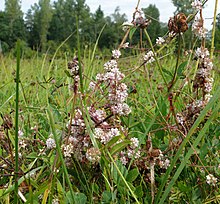| Cuscuta epithymum | |
|---|---|

| |
| Dodder parasitizing gorse (Ulex europaeus) | |
| Scientific classification | |
| Kingdom: | Plantae |
| Clade: | Tracheophytes |
| Clade: | Angiosperms |
| Clade: | Eudicots |
| Clade: | Asterids |
| Order: | Solanales |
| Family: | Convolvulaceae |
| Genus: | Cuscuta |
| Species: | C. epithymum
|
| Binomial name | |
| Cuscuta epithymum | |
| Synonyms | |
|
Lepimenes epithymum (L.) Raf.[3] | |

Cuscuta epithymum (dodder, lesser dodder, hellweed, strangle-tare) is a parasitic plant assigned to the family Cuscutaceae or Convolvulaceae, depending on the taxonomy. It is red-pigmented, not being photosynthetically active. It has a filiform habit, like a group of yarns. Its leaves are very small, like flakes. Its flowers, disposed in little glomerules, have a white corolla, with the androecium welded to the corolla.
In Eurasia, this species of dodder would often attach itself to the Conehead thyme (Thymus capitatus), taking on the plant's pungency. This gave rise to its specific name, which means upon thyme and from whence it also derived its host's Arabic name, al-ṣaʿitrah.[6]
- ^ "Systema vegetabilium ed 13". Linnean Collections. 1774. p. 140. Retrieved 14 July 2018.
- ^ "IPNI Cuscuta epithymum". International Plant Name Index. Retrieved 14 July 2018.
- ^ Govaerts, R.; et al. (2018). "Plants of the World online Cuscuta epithymum". Board of Trustees of the Royal Botanic Gardens, Kew. Retrieved 14 July 2018.
- ^ "APNI Cuscuta epithymum". Australian Plant Name Index. Retrieved 14 July 2018.
- ^ Linnaeus, C. (1753) Species Plantarum 1: 124
- ^ Amar, Z.; Serri, Yaron (2004). The Land of Israel and Syria as Described by al-Tamimi – Jerusalem Physician of the 10th Century (in Hebrew). Ramat-Gan. pp. 70–72 (note 230). ISBN 965-226-252-8.
{{cite book}}: CS1 maint: location missing publisher (link) -- (OCLC 607157392)